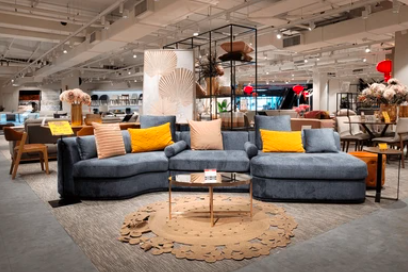
Bringing high-end custom furniture into Australia allows homeowners and designers to create bespoke interiors that showcase unique craftsmanship and premium materials. However, navigating the complexities of international shipping, customs regulations, and logistics requires careful planning. Whether you’re furnishing a new home or sourcing statement pieces for a project, ensuring safe and efficient transport is crucial. Reliable cargo services play a key role in simplifying this process, making international furniture imports seamless and stress-free.
Understanding the Import Process
Many individuals researching furniture imports to Australia start by understanding the logistics involved. Importing furniture isn’t as simple as selecting a piece from an international supplier and having it shipped. Australia enforces strict regulations on goods entering the country, particularly on items containing wood, upholstery, or composite materials. Biosecurity laws require some materials to undergo fumigation or meet specific treatment standards before entry. Additionally, import duties and taxes apply, affecting the final cost of acquiring luxury furniture from overseas.
Preparing for these logistical and regulatory hurdles ahead of time prevents unexpected complications. A well-documented import declaration and accurate classification of goods streamline customs clearance, reducing the likelihood of delays and additional expenses. Packaging also plays a key role, as high-end furniture often requires specialized crating, protective padding, or even climate-controlled transportation to ensure it remains in pristine condition throughout its journey.
Choosing the Right Supplier
Sourcing high-end furniture from an international market means working with a trusted supplier. A reputable manufacturer or dealer should have a track record of exporting furniture to Australia, provide detailed material specifications, and ensure compliance with international safety standards. Australian customs regulations require strict adherence to import laws, so verifying that all paperwork, such as invoices and compliance certificates, is in order will help facilitate a smooth import process.
Establishing a direct line of communication with suppliers allows buyers to clarify shipping lead times, packaging methods, and customization options. Many homeowners and businesses prefer importing furniture from Europe, Southeast Asia, or North America due to their high-quality craftsmanship and diverse design styles. Attending international trade fairs, requesting sample materials, and checking supplier reviews are effective ways to ensure product quality before placing large orders. Having a supplier who understands global logistics and works with reliable cargo services can also make a significant difference in shipping efficiency.
Selecting the Best Freight and Cargo Service
The next critical decision is choosing the best shipping method for transporting oversized furniture. Large and delicate furniture pieces require specialized handling, making the selection of a reliable cargo service essential to prevent damage and ensure cost-effective transport.
For most furniture imports, sea freight is the preferred option due to its affordability. Full Container Load (FCL) shipments are ideal for those importing multiple pieces or larger orders, as they offer exclusive use of a shipping container, reducing handling risks. Less than Container Load (LCL) shipments, while cost-effective, involve sharing space with other cargo, increasing exposure to potential damage during transit.
For urgent shipments, air freight provides a faster alternative but comes at a premium cost. Businesses importing time-sensitive, high-value furniture may choose this option despite its higher price. Experienced cargo services ensure that shipments are securely packed, tracked, and handled with care throughout transit, significantly reducing risks.
One of the most effective ways to ensure a hassle-free import process is to work with a logistics provider specializing in Project Cargo Services. MCC World International offers tailored solutions for oversized and high-value shipments, ensuring that every stage—from packaging and loading to customs clearance and final delivery—is executed efficiently. Their expertise in handling custom furniture imports minimizes risks and ensures that shipments arrive in perfect condition.
Navigating Australian Customs and Biosecurity Regulations
Once the shipment reaches Australia, it must go through customs clearance before delivery. Proper documentation, including commercial invoices, packing lists, and compliance certificates, is essential to avoiding delays. Import duties and Goods and Services Tax (GST) are calculated based on the furniture’s value, country of origin, and material composition.
Biosecurity requirements are particularly strict for wooden furniture, as untreated timber can pose a risk to Australia’s environment. Importers must ensure that their products meet the country’s stringent quarantine regulations, including fumigation or heat treatment, to avoid rejection or costly hold-ups at the border. Working with a freight forwarder experienced in Australian customs regulations ensures that all necessary documentation and treatments are completed before the shipment arrives.
Coordinating Final Delivery and Installation
Once customs clearance is complete, the furniture must be transported to its final destination. This stage requires careful coordination, particularly for large or delicate pieces. Choosing the right cargo service is crucial to ensuring the safe handling and final placement of high-end furniture.
Many logistics providers offer white-glove delivery services, which include unpacking, assembly, and even placement within the home or business. For furniture destined for high-rise apartments, commercial spaces, or locations with restricted access, specialized delivery teams equipped with hoisting equipment or liftgate trucks may be required. Proper planning at this stage prevents last-minute delivery challenges and ensures a smooth transition from warehouse to living space.
The Role of Insurance in Furniture Imports
High-value furniture shipments require proper insurance coverage to mitigate risks associated with international transport. Importers should consider marine cargo insurance, which protects against damage, loss, or delays caused by unforeseen circumstances such as port congestion, mishandling, or extreme weather conditions. Many professional cargo services offer insurance as part of their logistics packages, allowing homeowners and businesses to safeguard their investments during transit.
Partnering with a logistics provider experienced in handling high-end furniture minimizes risks and ensures that shipments reach their destination securely. MCC World International provides customized Project Cargo Services, ensuring that each shipment is handled with precision and delivered without unnecessary delays or complications.
Ensuring a Smooth Import Experience
Importing high-end custom furniture enhances the aesthetic and functional value of any space, but it requires a well-structured approach. From supplier selection and freight coordination to customs clearance and final delivery, every step matters in ensuring a seamless import experience.
Choosing an experienced freight partner that offers specialized cargo services streamlines the process, reduces risks, and ensures that shipments arrive safely. Whether sourcing bespoke furniture from international markets or handling large-scale commercial imports, having a structured logistics plan in place allows homeowners and businesses to focus on their design vision without logistical setbacks. With the right strategy, expert guidance, and reliable Project Cargo Services, importing luxury furniture into Australia becomes a smooth and rewarding process.
